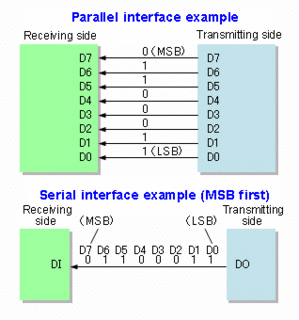Verilog, standardized as IEEE 1364, is a hardware description language (HDL) used to model electronic systems. It is most commonly used in the design and verification of digital circuits at the register-transfer level of abstraction. It is also used in the verification of analog circuits and mixed-signal circuits, as well as in the design of genetic circuits. In 2009, the Verilog standard was merged into the SystemVerilog standard, creating IEEE Standard 1800-2009. Since then, Verilog is officially part of the SystemVerilog language. The current version is IEEE standard 1800-2017.
In computer engineering, a hardware description language (HDL) is a specialized computer language used to describe the structure and behavior of electronic circuits, and most commonly, digital logic circuits.
In digital circuit theory, sequential logic is a type of logic circuit whose output depends not only on the present value of its input signals but on the sequence of past inputs, the input history as well. This is in contrast to combinational logic, whose output is a function of only the present input. That is, sequential logic has state (memory) while combinational logic does not.

In telecommunication and data transmission, serial communication is the process of sending data one bit at a time, sequentially, over a communication channel or computer bus. This is in contrast to parallel communication, where several bits are sent as a whole, on a link with several parallel channels.
In computer science, communicating sequential processes (CSP) is a formal language for describing patterns of interaction in concurrent systems. It is a member of the family of mathematical theories of concurrency known as process algebras, or process calculi, based on message passing via channels. CSP was highly influential in the design of the occam programming language, and also influenced the design of programming languages such as Limbo, RaftLib, Go, Crystal, and Clojure's core.async.
SystemC is a set of C++ classes and macros which provide an event-driven simulation interface. These facilities enable a designer to simulate concurrent processes, each described using plain C++ syntax. SystemC processes can communicate in a simulated real-time environment, using signals of all the datatypes offered by C++, some additional ones offered by the SystemC library, as well as user defined. In certain respects, SystemC deliberately mimics the hardware description languages VHDL and Verilog, but is more aptly described as a system-level modeling language.
In electronics, logic synthesis is a process by which an abstract specification of desired circuit behavior, typically at register transfer level (RTL), is turned into a design implementation in terms of logic gates, typically by a computer program called a synthesis tool. Common examples of this process include synthesis of designs specified in hardware description languages, including VHDL and Verilog. Some synthesis tools generate bitstreams for programmable logic devices such as PALs or FPGAs, while others target the creation of ASICs. Logic synthesis is one aspect of electronic design automation.
A synchronous circuit is a digital circuit in which the changes in the state of memory elements are synchronized by a clock signal. In a sequential digital logic circuit, data is stored in memory devices called flip-flops or latches. The output of a flip-flop is constant until a pulse is applied to its "clock" input, upon which the input of the flip-flop is latched into its output. In a synchronous logic circuit, an electronic oscillator called the clock generates a string of pulses, the "clock signal". This clock signal is applied to every storage element, so in an ideal synchronous circuit, every change in the logical levels of its storage components is simultaneous. Ideally, the input to each storage element has reached its final value before the next clock occurs, so the behaviour of the whole circuit can be predicted exactly. Practically, some delay is required for each logical operation, resulting in a maximum speed at which each synchronous system can run.
In electronic design a semiconductor intellectual property core, IP core, or IP block is a reusable unit of logic, cell, or integrated circuit layout design that is the intellectual property of one party. IP cores may be licensed to another party or can be owned and used by a single party alone. The term is derived from the licensing of the patent and/or source code copyright that exist in the design. IP cores can be used as building blocks within application-specific integrated circuit (ASIC) designs or field-programmable gate array (FPGA) logic designs.
A synchronous programming language is a computer programming language optimized for programming reactive systems. Computer systems can be sorted in three main classes: (1) transformational systems that take some inputs, process them, deliver their outputs, and terminate their execution; a typical example is a compiler; (2) interactive systems that interact continuously with their environment, at their own speed; a typical example is the web; and (3) reactive systems that interact continuously with their environment, at a speed imposed by the environment; a typical example is the automatic flight control system of modern airplanes. Reactive systems must therefore react to stimuli from the environment within strict time bounds. For this reason they are often also called real-time systems, and are found often in embedded systems.
The primary focus of this article is asynchronous control in digital electronic systems. In a synchronous system, operations are coordinated by one, or more, centralized clock signals. An asynchronous digital system, in contrast, has no global clock. Asynchronous systems do not depend on strict arrival times of signals or messages for reliable operation. Coordination is achieved via events such as: packet arrival, changes (transitions) of signals, handshake protocols, and other methods.
Handel-C is a high-level programming language which targets low-level hardware, most commonly used in the programming of FPGAs. It is a rich subset of C, with non-standard extensions to control hardware instantiation with an emphasis on parallelism. Handel-C is to hardware design what the first high-level programming languages were to programming CPUs. Unlike many other design languages that target a specific architecture Handel-C can be compiled to a number of design languages and then synthesised to the corresponding hardware. This frees developers to concentrate on the programming task at hand rather than the idiosyncrasies of a specific design language and architecture.

Quite Universal Circuit Simulator (Qucs) is a free-software electronics circuit simulator software released under GPL. It gives you the ability to set up a circuit with a graphical user interface and simulate the large-signal, small-signal and noise behaviour of the circuit. Pure digital simulations are also supported using VHDL and/or Verilog.
Verilog-AMS is a derivative of the Verilog hardware description language that includes analog and mixed-signal extensions (AMS) in order to define the behavior of analog and mixed-signal systems. It extends the event-based simulator loops of Verilog/SystemVerilog/VHDL, by a continuous-time simulator, which solves the differential equations in analog-domain. Both domains are coupled: analog events can trigger digital actions and vice versa.
Flow to HDL tools and methods convert flow-based system design into a hardware description language (HDL) such as VHDL or Verilog. Typically this is a method of creating designs for field-programmable gate array, application-specific integrated circuit prototyping and digital signal processing (DSP) design. Flow-based system design is well-suited to field-programmable gate array design as it is easier to specify the innate parallelism of the architecture.
Aldec, Inc. is a privately owned electronic design automation company based in Henderson, Nevada that provides software and hardware used in creation and verification of digital designs targeting FPGA and ASIC technologies.
In computing, a channel is a model for interprocess communication and synchronization via message passing. A message may be sent over a channel, and another process or thread is able to receive messages sent over a channel it has a reference to, as a stream. Different implementations of channels may be buffered or not, and either synchronous or asynchronous.
A hardware verification language, or HVL, is a programming language used to verify the designs of electronic circuits written in a hardware description language. HVLs typically include features of a high-level programming language like C++ or Java as well as features for easy bit-level manipulation similar to those found in HDLs. Many HVLs will provide constrained random stimulus generation, and functional coverage constructs to assist with complex hardware verification.



